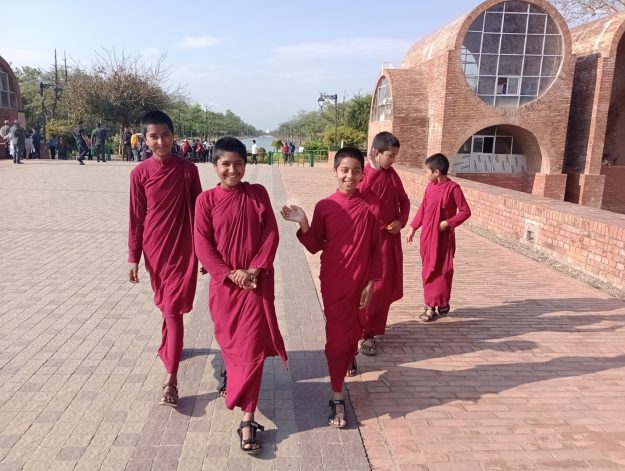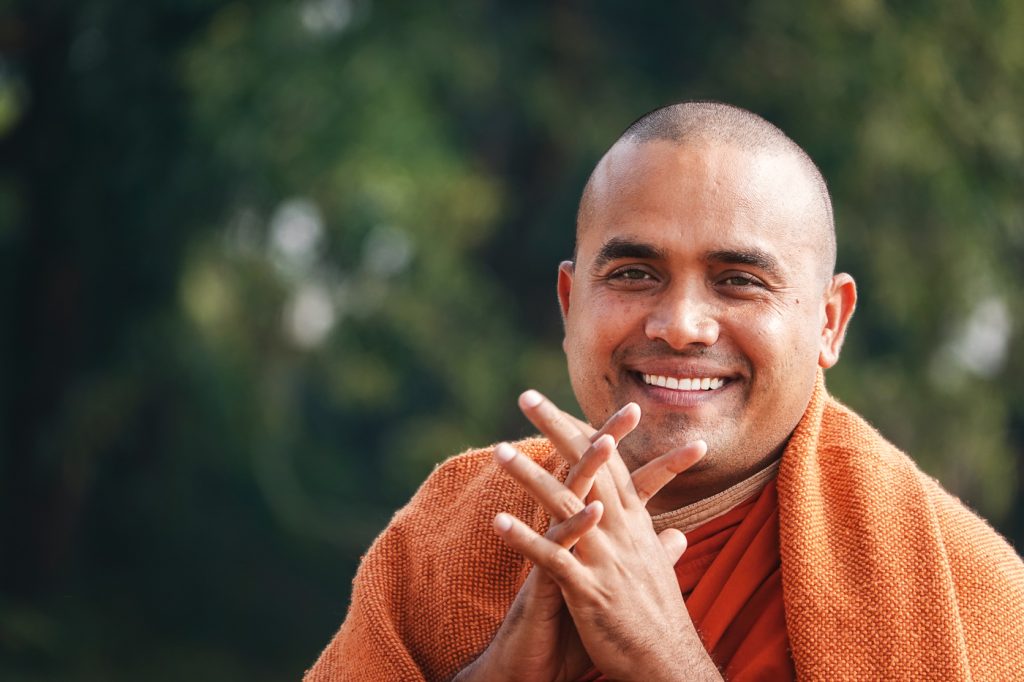The girls are waiting for me at the entrance of the Bodhi Institute, smiling and holding kata scarves and bundles of flowers—hibiscus, a fiery orange flower from an Ashoka tree, and other flora that have been growing in Lumbini since the time of the Buddha. The girls are a little bit shy when giving me the gifts. Then, suddenly, the little ones wrap me up in a group hug. For the next five days, they’re my personal holy-girl gang, showing me around the place where the Buddha was born.
I’d come to Lumbini in southern Nepal to meet with the Buddhist monk Metteyya Sakyaputta, who has devoted his life to this sacred city that is also his hometown and to the girls growing up in and around it. In rural Nepal, it’s not uncommon for girls as young as 10 to be married and move into their husband’s family’s home and begin serving as a housewife. An April 2023 UNICEF report found that South Asia, with 290 million child brides, was home to nearly half the total global number of married girls, even though child marriage has long been illegal.
Every year, an estimated 1.5 million people visit Lumbini, where, according to most Buddhist traditions, the Buddha was born. There are over thirty monasteries here, and at times the monastic community is estimated in the tens of thousands.
Lumbini is one of the four most important pilgrimage sites in Buddhism.
For the last two decades, Metteyya and his team at Lumbini Social Service Foundation have worked to open schools for children in the Lumbini area. Until recently, Metteyya served as the vice chair of the Lumbini Development Trust, a governmental organization tasked with carrying out the Lumbini Master Plan, developed by the Japanese architect Kenzo Tange (1913–2005). He is also president of the Lumbini Crane Foundation. His more recent endeavors include Peace Grove Nunnery, which at the time of my visit in March 2023 had nineteen nuns, aged 9 to 17, living at the Bodhi Institute.
It may seem like an odd occupation for a Theravada monk. The Vinaya, or monastic code, specifically prohibits a monk from being alone with a woman, in part to avoid the appearance of impropriety. When I ask Metteyya about it, he brushes this off as a dated social rule.
Since 2010, Metteyya has run a monastery where the girls live and study Buddhism, in addition to academic subjects at different schools in Lumbini, and they’ve welcomed new students ever since. The nuns take eight precept vows, and special accommodations are made because of their age. For example, younger nuns eat evening meals to help them grow. Metteyya says that the environment is at times “dharma light,” as he doesn’t want to put too much emphasis on suffering. Some of the nuns have already been married, he explains, and have already lived through extremely trying circumstances.
All the work done here flows back into the motivation to see Lumbini’s local community grow and thrive as outside investment and growing tourism bring in more and more people.
Now 38, Metteyya was born Awadhesh Tripathi in a nearby village. He describes his family as devout Brahmins and the women in his family as strong matriarchs who guided and nurtured his extended family of sixteen people. Growing up, he knew Hindu scriptures well from his grandparents’ daily prayers and was curious during his school years about Buddhism and its role in the history of Lumbini. Metteyya became a student of the Venerable Sujata, who was among the founding nuns of the Nepalese Bhikkhuni order.
Metteyya’s family wanted him to study medicine, and at one time he thought that he would serve his community as a doctor, but his life took a different course. In the early days, he was back and forth between Kathmandu and Lumbini, and eventually had to make the decision between running the school and continuing his own studies. He picked the former, and what is now known as Metta School was incorporated in 2003.
Ordained as a monk in the Theravada tradition, he was given the dharma name Metteyya (Maitreya in Sanskrit), the future Buddha. Metteyya said his decision led to a few years when he and his father didn’t speak, but his family is now supportive and has donated money and furniture to the schools. They have even come in to advise the students.
Metteyya has also started Karuna Girls College and Pragya Gurukul School in a village outside Lumbini. Karuna is the only all-girls school in the region, and students there learn academics and job skills, as well as issues that are still very real problems in the villages surrounding Lumbini: child marriage, lack of family planning, and poor stewardship of the environment. The schools all operate on a dana model, with no mandatory tuition fees.
As the Buddha’s birthplace, Lumbini is one of the four most important pilgrimage sites in Buddhism. The other three are Bodhgaya, site of the Buddha’s enlightenment; Sarnath, where he gave his first sermon; and Kushinagar, where he passed away.
The tradition tells us that the Buddha’s mother, Queen Maya, or Maya Devi, enjoyed a comfortable pregnancy, and as the birth approached, she set off from the palace in Kapilavastu for her parents’ home in Devadha. The queen and her entourage stopped on the way in Lumbini to enjoy the cool shade provided by a grove of sal trees. There she rested, surrounded by singing birds, buzzing bees, and blooming flowers. She began laboring and, while gracefully standing with her arm draped over a tree, gave birth to the boy that would become the Buddha.
The Maya Devi Temple marks the site where it is believed Maya Devi gave birth. The surrounding gardens are beautiful, adorned with prayer flags that dance in the breeze. The birds keep singing, the bees keep buzzing, and the flowers still bloom. Monastics of many different traditions meditate, chant, and speak the dharma around the complex (some bring microphones and speakers so that they’re the loudest), and many gather under the oldest and largest banyan tree. Sleepy monkeys recline and snack in the trees above.

Lumbini remained hidden to the outside world until the turn of the 20th century, when surveyors, using Buddhist writings as a guide, rediscovered the Ashoka Pillar. But according to Metteyya, Lumbini locals never forgot about the sacred spot. The grove was revered as a fertility shrine by local Hindu women. Metteyya’s grandmother brought the hair from his first haircut—an important Hindu rite of passage—there for a blessing.
With the rediscovery, the outside world came back to Lumbini. Archaeologists excavated the mounds built over the site of the Buddha’s birthplace. Monasteries and guest houses were built. After a life-changing pilgrimage by United Nations Secretary-General U Thant in 1967, Lumbini gained the support of the UN. During the seventies, the influential brutalist architect Kenzo Tange created a development plan aimed at preserving Lumbini as a spiritual site and welcoming visitors from around the world. Tange recommended a five-mile-by-five-mile zone centered on the “Sacred Garden” where Maya Devi gave birth to the Buddha. Tange’s plan includes space for forty-five monasteries and meditation centers in two monastic zones.
The redevelopment has, however, turned Lumbini into a Buddhist “Disney World,” Metteyya says. Indeed, the properties, built by various countries, are beautiful and ornate, with manicured lawns and gardens. But residents from seven villages were relocated as part of the plan, and the land was turned into a crane sanctuary.
“We have these beautiful, world-class monuments, but outside [the monastic zone], life is pretty much the same,” Metteyya says.
Four decades after the master plan was adopted, it’s about 80 percent complete. Over the years in his role at the Lumbini Land Trust, Metteyya spent a lot of time with visiting dignitaries and also making sure Lumbini isn’t overdeveloped. (Metteyya ended his term in late 2023.) Gautam Buddha International Airport opened near Lumbini in May 2022, giving international pilgrims and visitors direct access to the holy site.
And the work with the girls goes on. Trust in Metteyya and his team has paved the way for significant change in a short amount of time. Graduates have gone on to become nurse-midwives serving the area, while others have become housewives or serve on public boards. Some graduates have traveled to Sri Lanka to continue to live as nuns and study Buddhism. They ride motorbikes, and locals no longer bat an eye.
Though Bodhi Institute is protected, it’s far from closed off. The girls travel home on school breaks and some weekends; those who live farther away from Lumbini go with their school sisters’ families. Bodhi Institute hosts sleepovers for the girls and their mothers. Amma Café, which is along the canal leading up the Maya Devi Temple, sells tea, coffee, and local sweets like laddu, a rice ball treat, and is staffed with all women from Lumbini. Amma means mother in Nepali, and many of the women who work at Amma Café have children who attend schools started by Metteyya.
The women of Lumbini are the spiritual heirs of Maya Devi and Mahapajapati Gotami, Maya Devi’s sister and the Buddha’s adoptive mother, who successfully argued that women should have an equal place in the sangha. And they can have the power and confidence of both the Buddha’s mothers to do great things.
When Metteyya and his group of social workers are convincing parents to send their girls to school or to extend their education, they emphasize that the world they live in today isn’t the same one the parents grew up in. Earning money for the family is important, and the girls will have to live one day without their parents’ help.
“And that’s what we wanted to create,” Metteyya says. “If there’s one woman who [demonstrates] that they can be independent, earn a decent living, raise a good family, and be accepted, then it becomes OK in our culture. And hundreds of women can follow her.”
Thank you for subscribing to Tricycle! As a nonprofit, we depend on readers like you to keep Buddhist teachings and practices widely available.
